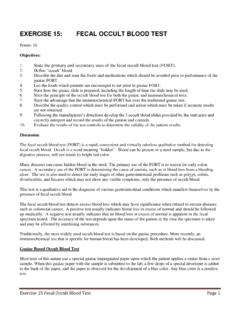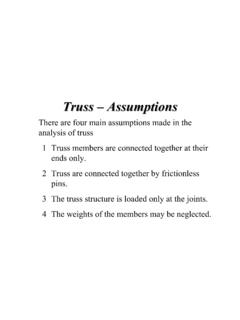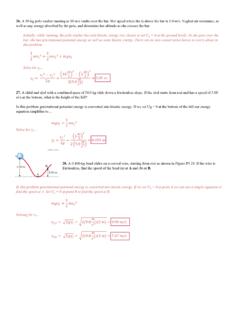Transcription of Sample Exercise 17.1 Calculating the pH When a Common Ion ...
1 Copyright 2009 by Pearson Education, Saddle River, New Jersey 07458 All rights : The Central Science, Eleventh EditionBy Theodore E. Brown, H. Eugene LeMay, Bruce E. Bursten, and Catherine J. MurphyWith contributions from Patrick WoodwardSample Exercise Calculating the pH When a Common Ion is InvolvedWhat is the pH of a solution made by adding mol of acetic acid and mol of sodium acetate to enough water to make L of solution?SolutionAnalyze: We are asked to determine the pH of a solution of a weak electrolyte (CH3 COOH) and a strong electrolyte (CH3 COONa) that share a Common ion, CH3 COO .Plan: In any problem in which we must determine the pH of a solution containing a mixture of solutes, it is helpful to proceed by a series of logical steps:1. Consider which solutes are strong electrolytes and which are weak electrolytes, and identify the major species in Identify the important equilibrium that is the source of H+and therefore determines Tabulate the concentrations of ions involved in the Use the equilibrium -constant expression to calculate [H+] and then : First, because CH3 COOH is a weak electrolyte and CH3 COONa is a strong electrolyte, the major species in the solution are CH3 COOH (a weak acid), Na+(which is neither acidic nor basic and is therefore a spectator in the acid base chemistry), and CH3 COO (which is the conjugate base of CH3 COOH).
2 Second, [H+] and, therefore, the pH are controlled by the dissociation equilibrium of CH3 COOH:(We have written the equilibrium Using H+(aq) rather than H3O+(aq) but both representations of the hydrated hydrogen ion are equally valid.)Copyright 2009 by Pearson Education, Saddle River, New Jersey 07458 All rights : The Central Science, Eleventh EditionBy Theodore E. Brown, H. Eugene LeMay, Bruce E. Bursten, and Catherine J. MurphyWith contributions from Patrick WoodwardSample Exercise Calculating the pH When a Common Ion is InvolvedSolution (Continued)Third, we tabulate the initial andequilibrium concentrations as we didin solving other equilibrium problems in Chapters 15 and 16:The equilibrium concentration of CH3 COO (the Common ion) is theinitial concentration that is due toCH3 COONa ( M) plus the change in concentration (x) that is due to the ionization of we can use the equilibrium -constant expression:(The dissociation constant forCH3 COOH at 25 C is from Appendix D; addition of CH3 COONa does notchange the value of this constant.)
3 Substituting the equilibrium -constantconcentrations from our table intothe equilibrium expression givesCopyright 2009 by Pearson Education, Saddle River, New Jersey 07458 All rights : The Central Science, Eleventh EditionBy Theodore E. Brown, H. Eugene LeMay, Bruce E. Bursten, and Catherine J. MurphyWith contributions from Patrick WoodwardSample Exercise Calculating the pH When a Common Ion is InvolvedCalculate the pH of a solution containing M nitrous acid (HNO2; Ka= 10-4) and M potassium nitrite (KNO2).Answer: ExerciseSolution (Continued)Because Kais small, we assume that x is small compared to the original concentrations of CH3 COOH and CH3 COO ( M each). Thus, we can ignore the very small x relative to M, givingThe resulting value of x is indeedsmall relative to , justifying theapproximation made in simplifyingthe resulting value of x is indeedsmall relative to , justifying theapproximation made in simplifyingthe , we calculate the pH from the equilibrium concentration of H+(aq):Comment: In Section we calculated that a M solution of CH3 COOH has a pH of , corresponding to H+] = 10-3M.
4 Thus, the addition of CH3 COONa has substantially decreased , [H+] as we would expect from Le Ch telier s 2009 by Pearson Education, Saddle River, New Jersey 07458 All rights : The Central Science, Eleventh EditionBy Theodore E. Brown, H. Eugene LeMay, Bruce E. Bursten, and Catherine J. MurphyWith contributions from Patrick WoodwardSample Exercise Calculating Ion Concentrations When a Common is InvolvedCalculate the fluoride ion concentration and pH of a solution that is M in HF and M in : We can again use the four steps outlined in Sample Exercise : Because HF is a weak acid andHCl is a strong acid, the major speciesin solution are HF, H+ , and Cl . TheCl , which is the conjugate base of astrong acid, is merely a spectator ionin any acid base chemistry. The problemasks for [F ] , which is formed byionization of HF. Thus, the importantequilibrium isThe Common ion in this problem isthe hydrogen (or hydronium) we can tabulate the initial andequilibrium concentrations of eachspecies involved in this equilibrium :The equilibrium constant for theionization of HF, from Appendix D,is 10-4.
5 Substituting theequilibrium-constant concentrationsinto the equilibrium expression givesCopyright 2009 by Pearson Education, Saddle River, New Jersey 07458 All rights : The Central Science, Eleventh EditionBy Theodore E. Brown, H. Eugene LeMay, Bruce E. Bursten, and Catherine J. MurphyWith contributions from Patrick WoodwardSample Exercise Calculating Ion Concentrations When a Common is InvolvedCalculate the formate ion concentration and pH of a solution that is M in formic acid (HCOOH; Ka= 10-4) and M in : [HCOO ] = 10-5; pH = ExerciseComment: Notice that for all practical purposes, [H+] is due entirely to the HCl; the HF makes a negligible contribution by (Continued)If we assume that x is small relative to or M, this expression simplifies toThis F concentration is substantiallysmaller than it would be in a Msolution of HF with no added Common ion, H+, suppresses theionization of HF.
6 The concentration of H+(aq) isThus,Copyright 2009 by Pearson Education, Saddle River, New Jersey 07458 All rights : The Central Science, Eleventh EditionBy Theodore E. Brown, H. Eugene LeMay, Bruce E. Bursten, and Catherine J. MurphyWith contributions from Patrick WoodwardSample Exercise Calculating the pH of a BufferWhat is the pH of a buffer that is M in lactic acid [CH3CH(OH)COOH, or HC3H5O3] and M in sodium lactate [CH3CH(OH)COONa or NaC3H5O3]? For lactic acid, Ka= : We are asked to calculate the pH of a buffer containing lactic acid HC3H5O3and its conjugate base, the lactate ion (C3H5O3 ).Plan: We will first determine the pH using the method described in Section Because HC3H5O3is a weak electrolyte andNaC3H5O3is a strong electrolyte, the major species in solution are HC3H5O3, Na+, and C3H5O3 . The Na+ion is a spectator ion. The HC3H5O3 C3H5O3 conjugate acid base pair determines [H+] and thus pH; [H+] can be determined using the aciddissociation equilibrium of lactic : The initial and equilibriumconcentrations of the species involvedin this equilibrium areThe equilibrium concentrations are governed by the equilibrium expression:Copyright 2009 by Pearson Education, Saddle River, New Jersey 07458 All rights : The Central Science, Eleventh EditionBy Theodore E.
7 Brown, H. Eugene LeMay, Bruce E. Bursten, and Catherine J. MurphyWith contributions from Patrick WoodwardSample Exercise Calculating the pH of a BufferCalculate the pH of a buffer composed of M benzoic acid and M sodium benzoate. (Refer to Appendix D.)Answer: ExerciseSolution (Continued)Because Kais small and a Common ion is present, we expect x to be small relative to either or M. Thus, our equation can be simplified to giveSolving for x gives a value that justifies our approximation:Alternatively, we could have used the Henderson Hasselbalch equation to calculate pH directly:Copyright 2009 by Pearson Education, Saddle River, New Jersey 07458 All rights : The Central Science, Eleventh EditionBy Theodore E. Brown, H. Eugene LeMay, Bruce E. Bursten, and Catherine J. MurphyWith contributions from Patrick WoodwardSample Exercise Preparing a BufferHow many moles of NH4Cl must be added to L of M NH3to form a buffer whose pH is (Assume that the addition of NH4Cl does not change the volume of the solution.)
8 SolutionAnalyze: Here we are asked to determine the amount of NH4+ion required to prepare a buffer of a specific : The major species in the solution will be NH4+, Cl , and NH3. Of these, the ion is a spectator (it isthe conjugate base of a strong acid).Thus, the NH4+ NH3conjugate acid base pair will determine the pHof the buffer solution. The equilibriumrelationship between NH4+and NH3is given by the basedissociation constant for NH3:The key to this Exercise is to use this Kbexpression to calculate [NH4+].Solve: We obtain [OH ] from the given pH:and soBecause Kbis small and the commonion NH4+is present, the equilibriumconcentration of NH3will essentiallyequal its initial concentration:Copyright 2009 by Pearson Education, Saddle River, New Jersey 07458 All rights : The Central Science, Eleventh EditionBy Theodore E. Brown, H. Eugene LeMay, Bruce E. Bursten, and Catherine J.
9 MurphyWith contributions from Patrick WoodwardSample Exercise Preparing a BufferCalculate the concentration of sodium benzoate that must be present in a M solution of benzoic acid (C6H5 COOH) to produce a pH of : MPractice ExerciseSolution (Continued)Comment: Because NH4+and NH3are a conjugate acid base pair, we could use the Henderson Hasselbalch equation (Equation ) to solve this problem . To do so requires first using Equation to calculate pKafor NH4+from the value of pKbfor NH3. We suggest you try this approach to convince yourself that you can use the Henderson Hasselbalch equation for buffers for which you are given Kbfor the conjugate base rather than Kafor the conjugate now use the expression for Kbtocalculate [NH4+]:Thus, for the solution to have pH = , [NH4+] must equal M. The number of moles of NH4Cl needed to produce this concentration is given by the product of the volume of the solution and its molarity:Copyright 2009 by Pearson Education, Saddle River, New Jersey 07458 All rights : The Central Science, Eleventh EditionBy Theodore E.
10 Brown, H. Eugene LeMay, Bruce E. Bursten, and Catherine J. MurphyWith contributions from Patrick WoodwardSample Exercise Calculating pH Changes in BuffersA buffer is made by adding mol CH3 COOH and mol CH3 COONa to enough water to make L of solution. The pH of the buffer is ( Sample Exercise ). (a) Calculate the pH of this solution after mol of NaOH is added. (b) For comparison, calculate the pH that would result if mol of NaOH were added to L of pure water (neglect any volume changes).SolutionAnalyze: We are asked to determine the pH of a buffer after addition of a small amount of strong base and to compare the pH change to the pH that would result if we were to add the same amount of strong base to pure : (a) solving this problem involves the two steps outlined in Figure Thus, we must first do a stoichiometry calculation to determine how the added OH reacts with the buffer and affects its composition.


















